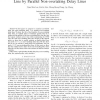Free Online Productivity Tools
i2Speak
i2Symbol
i2OCR
iTex2Img
iWeb2Print
iWeb2Shot
i2Type
iPdf2Split
iPdf2Merge
i2Bopomofo
i2Arabic
i2Style
i2Image
i2PDF
iLatex2Rtf
Sci2ools
INFOCOM
2009
IEEE
2009
IEEE
Emulation and Approximation of a Flexible Delay Line by Parallel Non-Overtaking Delay Lines
—In this paper we propose to construct an flexible delay line with maximum delay d by parallel non-overtaking delay lines. We show that for a fixed number of non-overtaking delay lines, an optimal policy to minimize packet losses is to assign arriving packets to the non-overtaking delay line that has the largest residual service time while maintaining the FIFO order for each non-overtaking delay lines. Based on this optimal policy we show that to exactly emulate an flexible delay line, one needs (d + 1)/2 non-overtaking delay lines. We also show that if one can tolerate a small packet loss probability, one just needs O( √ d) non-overtaking delay lines. In this case, we show that the residual service times of the non-overtaking delay lines behaved as if they followed the order statistics of uniform random variables.
| Added | 24 May 2010 |
| Updated | 24 May 2010 |
| Type | Conference |
| Year | 2009 |
| Where | INFOCOM |
| Authors | Duan-Shin Lee, Kai-Jie Hsu, Cheng-Shang Chang, Jay Cheng |
Comments (0)

